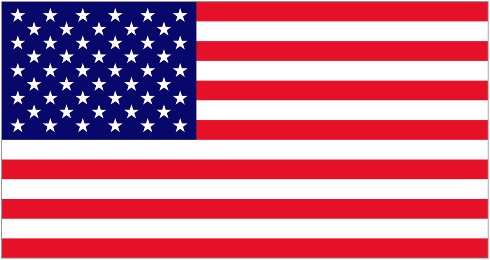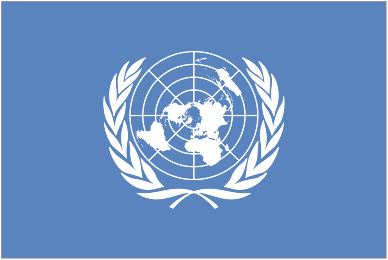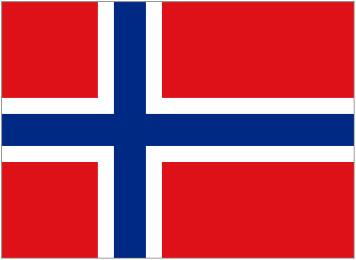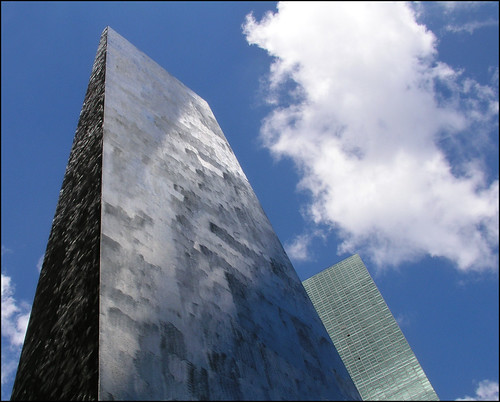
|  |
Ralph Bunche [1903-1971] |
Ralph Bunche [1903-1971] was an American political scientist & diplomat who received the 1950 Nobel Peace Prize for his late 1940's mediation in Palestine. He was the first person of color to be so honored in the history of the Prize. He was involved in the formation & administration of the United Nations, In 1963, he received the Medal of Freedom from President John F. Kennedy. Bunche was born in Detroit, Michigan, on August 7, 1904, and died in New York City on December 9, 1971.
Bunche was involved with the United Nations from its beginning, serving as the principal author of two chapters of the UN charter - one on trusteeship & the other on non-self-governing territories. For brokering an armistice between Israel & its Arab neighbors, Bunche was awarded the Nobel Peace Prize in 1950, the first person of color to receive this highest of honors. He also served as a UN mediator in Egypt, the Congo & Yemen. At the time of his death, he was Under Secretary-General of the United Nations.
In addition to all of the monuments shown below, Ralph Bunche also had elementary schools named after him in Markham, Illinois; Ecorse, Michigan; Canton, Georgia; Miami, Florida; & New York City & a high school named after him in King George County, Virginia.
Right click image to enlarge.

 | M
A
R
K
E
R |   August 7, 1904 - Birth of Ralph Bunche, Detroit, Michigan (USA). On February 11, 1972, the site of his birth in Detroit was listed as a Michigan Historic Site. Mrs. Bunche was present for the unveiling of a historical marker on April 27, 1972 (image). August 7, 1904 - Birth of Ralph Bunche, Detroit, Michigan (USA). On February 11, 1972, the site of his birth in Detroit was listed as a Michigan Historic Site. Mrs. Bunche was present for the unveiling of a historical marker on April 27, 1972 (image).
|

| H
O
U
S
E |

 1920's - Ralph Bunche Peace & Heritage Center, South Los Angeles, California (USA). Boyhood home of Ralph Bunche. Declared a Historic-Cultural Monument (HCM #159) in 1976 by the Los Angeles Cutural Heritage Commission & listed in the National Register of Historic Places in 1978. His boyhood home with his grandmother in the Central Avenue Neighborhood of Los Angeles, has been listed on the National Register of Historic Places and City of Los Angeles Historic-Cultural Landmarks, HCM #159. The owner of the property, Dunbar Economic Development Corporation of Los Angeles, operates the home as a rehabilitated interpretive Museum and Community Center to promote peaceful interaction of all groups within South Central Los Angeles. The period of significance of the historic house museum is from the 1920's. The property was fully restored between 2002 and 2004, winning a Los Angeles Conservancy Award for Historic Preservation in 2006. 1920's - Ralph Bunche Peace & Heritage Center, South Los Angeles, California (USA). Boyhood home of Ralph Bunche. Declared a Historic-Cultural Monument (HCM #159) in 1976 by the Los Angeles Cutural Heritage Commission & listed in the National Register of Historic Places in 1978. His boyhood home with his grandmother in the Central Avenue Neighborhood of Los Angeles, has been listed on the National Register of Historic Places and City of Los Angeles Historic-Cultural Landmarks, HCM #159. The owner of the property, Dunbar Economic Development Corporation of Los Angeles, operates the home as a rehabilitated interpretive Museum and Community Center to promote peaceful interaction of all groups within South Central Los Angeles. The period of significance of the historic house museum is from the 1920's. The property was fully restored between 2002 and 2004, winning a Los Angeles Conservancy Award for Historic Preservation in 2006.
|

 | U
N
I
V |   1926 - Perhaps Bunche's best-known quote is taken from "That Man May Dwell in Peace," a speech from a college debate in 1926 at UCLA.
"What vast, undreamed of achievement might await man would he but devote his entire interest to promoting the commonweal of a universal human brotherhood." 1926 - Perhaps Bunche's best-known quote is taken from "That Man May Dwell in Peace," a speech from a college debate in 1926 at UCLA.
"What vast, undreamed of achievement might await man would he but devote his entire interest to promoting the commonweal of a universal human brotherhood."
|
1934 - Bunche received a doctorate at Harvard. His doctoral thesis was a study of colonialism, & it brought him a grant to study the status of non-European peoples in Africa. After four years he returned to the USA to work with Swedish sociologist Gunnar Myrdal [1898-1987] surveying the conditions of Blacks in America. The work was not without danger -- several times they were chased from Alabama towns by angry white mobs. Their surveys led to the publication of Myrdal's widely acclaimed 1944 book, "An American Dilemma: The Negro Problem & Modern Democracy."
From June 1947 to August 1949, American Ralph Bunche [1903-1971] worked on the most important assignment of his career - the confrontation between Arabs and Jews in Palestine. He was first appointed as assistant to the UN Special Committee on Palestine, then as principal secretary of the UN Palestine Commission, which was charged with carrying out the partition approved by the UN General Assembly. In early 1948 when this plan was dropped and fighting between Arabs and Israelis became especially severe, the UN appointed Count Folke Bernadotte [1895-1948] as mediator & Ralph Bunche as his chief aide. 
September 17, 1948 - UN mediator Folke Bernadotte is assassinated by the Lehi (Stern Group) (which is then banned by the Israeli government). American Ralph Bunche [1903-1971] is named acting UN mediator on Palestine. After eleven months of virtually ceaseless negotiating, Bunche obtained signatures on armistice agreements between Israel & the Arab States. 
|

| H
O
M
E |    Date? - Bunche returned home to a hero's welcome. New York gave him a "ticker tape" parade up Broadway. Los Angeles declared a "Ralph Bunche Day."
Date? - Bunche returned home to a hero's welcome. New York gave him a "ticker tape" parade up Broadway. Los Angeles declared a "Ralph Bunche Day."
|


| N
O
B
E
L |  1950 - Nobel Peace Prize. From his prize lecture: "Some Reflections on Peace in Our Time," delivered in 1950, Bunche urged the nations to employ reason in their dealings with each other:
"The United Nations does not seek a world cut after a single pattern, nor does it consider this desirable. The United Nations seeks only unity, not uniformity, out of the world's diversity. There will be no security in our world, no release from agonizing tension, no genuine progress, no enduring peace, until, in Shelley's fine words, 'reason's voice, loud as the voice of nature, shall have waked the nations." 1950 - Nobel Peace Prize. From his prize lecture: "Some Reflections on Peace in Our Time," delivered in 1950, Bunche urged the nations to employ reason in their dealings with each other:
"The United Nations does not seek a world cut after a single pattern, nor does it consider this desirable. The United Nations seeks only unity, not uniformity, out of the world's diversity. There will be no security in our world, no release from agonizing tension, no genuine progress, no enduring peace, until, in Shelley's fine words, 'reason's voice, loud as the voice of nature, shall have waked the nations."

|
  


| U
N
I
V |   May 1969 - Bust of Ralph Bunche, Bunche Hall, University of California Los Angeles (UCLA), Los Angeles, California (USA). In front of the Franklin Murphy Sculpture Garden. Has 25 General Assigment Classrooms, of which 16 are Media-Equipped. Images show Palm Court inside the hall & Bunche with Chancellor Charles Young at the hall's dedication. Ralph Bunche [1903-1971], was graduated from UCLA in 1927, received the Nobel Peace Prize in 1950, & died December 10, 1971, at age 68. May 1969 - Bust of Ralph Bunche, Bunche Hall, University of California Los Angeles (UCLA), Los Angeles, California (USA). In front of the Franklin Murphy Sculpture Garden. Has 25 General Assigment Classrooms, of which 16 are Media-Equipped. Images show Palm Court inside the hall & Bunche with Chancellor Charles Young at the hall's dedication. Ralph Bunche [1903-1971], was graduated from UCLA in 1927, received the Nobel Peace Prize in 1950, & died December 10, 1971, at age 68.
|
 | U
N
I
V |   1969 - Ralph J. Bunche Center for African American Studies, Campbell Hall, University of California Los Angeles (UCLA), Los Angeles, California (USA).
"Founded in 1969 as the Center for Afro-American Studies (CAAS), is the result of the struggle by black students at UCLA to have their history & culture recognized & studied.
While the fight to have African American Studies acknowledged as a legitimate field of study was taking place all over America during the 1960's, it took on special significance at UCLA when two Black Panthers were killed at Campbell Hall in January 1969 after a clash over who would lead the center." /// Image shows "a mural depicting proud, multigenerational African-American men, women & children in vibrant hues of green, orange and fuchsia [which for 21 years] greeted students, faculty & staff when they entered the main office for the Center for Afro-American Studies, later to be renamed the Ralph J. Bunche Center for African American Studies, in Campbell Hall.
But over the years, the origins of the 7-by-9-foot mural faded into obscurity. There was no plaque identifying the title or the artist. Finally, in 1991, the mural, painted on wooden panels, went into storage...." 1969 - Ralph J. Bunche Center for African American Studies, Campbell Hall, University of California Los Angeles (UCLA), Los Angeles, California (USA).
"Founded in 1969 as the Center for Afro-American Studies (CAAS), is the result of the struggle by black students at UCLA to have their history & culture recognized & studied.
While the fight to have African American Studies acknowledged as a legitimate field of study was taking place all over America during the 1960's, it took on special significance at UCLA when two Black Panthers were killed at Campbell Hall in January 1969 after a clash over who would lead the center." /// Image shows "a mural depicting proud, multigenerational African-American men, women & children in vibrant hues of green, orange and fuchsia [which for 21 years] greeted students, faculty & staff when they entered the main office for the Center for Afro-American Studies, later to be renamed the Ralph J. Bunche Center for African American Studies, in Campbell Hall.
But over the years, the origins of the 7-by-9-foot mural faded into obscurity. There was no plaque identifying the title or the artist. Finally, in 1991, the mural, painted on wooden panels, went into storage...."
|

| G
R
A
V
E |   December 9, 1971 - Death of Ralph Bunche in New York City. His grave is in Woodlawn Cemetery, Bronx, New York City (USA). The only inscription on the headstone is "BUNCHE" & two olive branches. December 9, 1971 - Death of Ralph Bunche in New York City. His grave is in Woodlawn Cemetery, Bronx, New York City (USA). The only inscription on the headstone is "BUNCHE" & two olive branches.
|

| U
N
I
V |   1972 - Ralph Bunche Peace & International House, Colgate University, 80 Broad Street, Hamilton, New York (USA). "Renovated in 1999-2000. With 16 single rooms, a nice kitchen & the student-run Cecilie's café in the basement, the house serves as well as the home of students who share an interest in international cultures & global peace." 1972 - Ralph Bunche Peace & International House, Colgate University, 80 Broad Street, Hamilton, New York (USA). "Renovated in 1999-2000. With 16 single rooms, a nice kitchen & the student-run Cecilie's café in the basement, the house serves as well as the home of students who share an interest in international cultures & global peace."
|

| W
A
L
L |

 1975 - Isaiah Wall, Ralph Bunche Park, East 43rd Street & First Avenue, New York City, New York (USA). Across First Avenue from UN Headquarters. Quotes Isaiah 2:4: "They shall beat their swords into plowshares." Shadow in image is cast by adjacent monument "Peace Form One" (see below). Entry #718 in the "Peace Movement Directory" by James Richard Bennett (2001).
Ralph Bunche [1903-1971] was an American diplomat & received the Nobel Peace Prize in 1950. 1975 - Isaiah Wall, Ralph Bunche Park, East 43rd Street & First Avenue, New York City, New York (USA). Across First Avenue from UN Headquarters. Quotes Isaiah 2:4: "They shall beat their swords into plowshares." Shadow in image is cast by adjacent monument "Peace Form One" (see below). Entry #718 in the "Peace Movement Directory" by James Richard Bennett (2001).
Ralph Bunche [1903-1971] was an American diplomat & received the Nobel Peace Prize in 1950. 
|

| M
O
N |   1980 - "Peace Form One", Ralph Bunche Park, East 43rd Street & First Avenue, New York City, New York (USA). Stainless-steel obelisk 50 feet (15 meters) high, honoring Ralph Bunche [1903-1971]. Adjacent to the Isaiah Wall. The sculptor, Daniel Larue Johnson, was a personal friend of Bunche, and dedicated the sculpture to Bunche, who won the Nobel Peace Prize in 1950.Entry #731 in the "Peace Movement Directory" by James Richard Bennett (2001). Ralph Bunche [1903-1971] received the Nobel Peace Prize in 1950. 1980 - "Peace Form One", Ralph Bunche Park, East 43rd Street & First Avenue, New York City, New York (USA). Stainless-steel obelisk 50 feet (15 meters) high, honoring Ralph Bunche [1903-1971]. Adjacent to the Isaiah Wall. The sculptor, Daniel Larue Johnson, was a personal friend of Bunche, and dedicated the sculpture to Bunche, who won the Nobel Peace Prize in 1950.Entry #731 in the "Peace Movement Directory" by James Richard Bennett (2001). Ralph Bunche [1903-1971] received the Nobel Peace Prize in 1950. 
|

| B
E
A
C
H |   Date? - Bunch Beach, near Ft. Myers, Florida (USA). An historic black beach, from the age of segregation, renamed for Ralph Bunche. "Bunche Beach is actually a small sandy beach in innermost San Carlos Bay, across the way from the north end of Estero Island (aka Ft. Myers Beach). This beach is extremely popular with humans, mainly because you don't have to fight the traffic to get to the islands. It's also popular with kayakers because it's a great place to launch into a quiet bay." Date? - Bunch Beach, near Ft. Myers, Florida (USA). An historic black beach, from the age of segregation, renamed for Ralph Bunche. "Bunche Beach is actually a small sandy beach in innermost San Carlos Bay, across the way from the north end of Estero Island (aka Ft. Myers Beach). This beach is extremely popular with humans, mainly because you don't have to fight the traffic to get to the islands. It's also popular with kayakers because it's a great place to launch into a quiet bay."
|

| T
O
W
N |   Date? - The neighborhood of Bunche Park in the city of Miami Gardens, Miami-Dade County, Florida, was named in honor of Ralph Bunche. Date? - The neighborhood of Bunche Park in the city of Miami Gardens, Miami-Dade County, Florida, was named in honor of Ralph Bunche.
|

 | S
T
A
M
P
|  January 12, 1982 - 20˘ US postage stamp. In "Great Americans" series. January 12, 1982 - 20˘ US postage stamp. In "Great Americans" series.
|

| U
N
I
V |   1996 - Ralph J. Bunche International Affairs Center, Howard University, Washington, DC (USA). "In 1996, Howard University named its international affairs center, a physical facility & associated administrative programs, for Bunche. The center is the site of lectures & internationally-oriented programming as well as serving as 'Howard's point of contact
for...foreign embassies, governments, universities & corporations, as well as US government agencies.'" 1996 - Ralph J. Bunche International Affairs Center, Howard University, Washington, DC (USA). "In 1996, Howard University named its international affairs center, a physical facility & associated administrative programs, for Bunche. The center is the site of lectures & internationally-oriented programming as well as serving as 'Howard's point of contact
for...foreign embassies, governments, universities & corporations, as well as US government agencies.'"
|
 | L
I
B
R
A
R
Y |   May 5, 1997 - Ralph J. Bunche Library, Room 3239, Harry S. Truman Building, US Department of State, Washjington, DC (USA). "The oldest Federal government library, founded by Secretary of State Thomas Jefferson in 1789. It was dedicated to & renamed the Ralph J. Bunche Library on May 5, 1997." Ralph Bunche [1903-1971] received the Nobel Peace Prize in 1950. May 5, 1997 - Ralph J. Bunche Library, Room 3239, Harry S. Truman Building, US Department of State, Washjington, DC (USA). "The oldest Federal government library, founded by Secretary of State Thomas Jefferson in 1789. It was dedicated to & renamed the Ralph J. Bunche Library on May 5, 1997." Ralph Bunche [1903-1971] received the Nobel Peace Prize in 1950. 
|

















